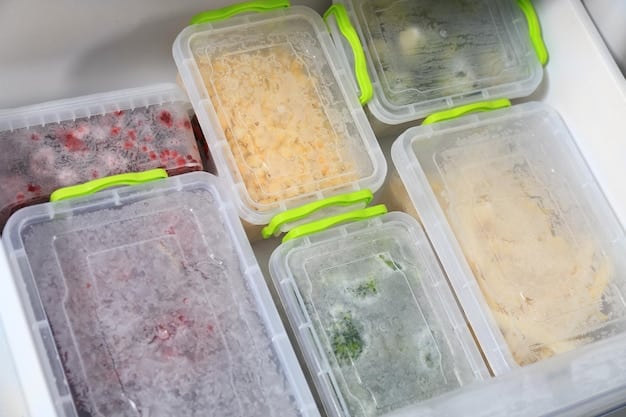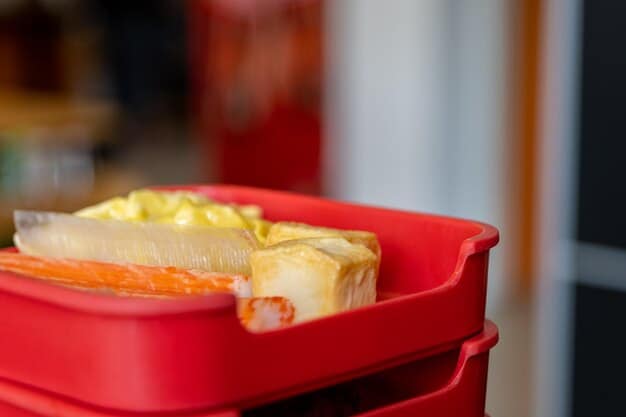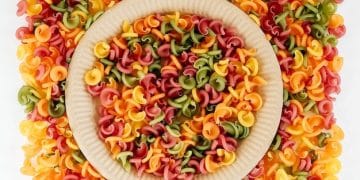The Ultimate Guide to Freezer Meal Planning: Save Money & Time

The Ultimate Guide to Freezer Meal Planning is your comprehensive resource for efficiently preparing and storing meals, saving you time and money throughout the year by reducing food waste and simplifying busy weeknight dinners.
Are you tired of last-minute dinner scrambles and watching your grocery budget disappear? The Ultimate Guide to Freezer Meal Planning: Save Time and Money All Year Long offers a practical solution to streamline your meal prep, reduce food waste, and enjoy delicious, home-cooked meals even on your busiest days. Let’s dive in!
Why Freezer Meal Planning is a Game Changer
Freezer meal planning isn’t just a trend; it’s a strategic approach to reclaim your time and take control of your food expenses. Imagine having a variety of meals ready to go in your freezer, eliminating the stress of nightly meal prep and reducing the temptation to order takeout.
But what exactly makes freezer meal planning so effective? Let’s explore the key benefits that can transform your kitchen routine.
Saves Time
One of the most significant advantages of freezer meal planning is the time it saves. By dedicating a few hours each week or month to prepare multiple meals at once, you free up valuable time during the weeknights when you’re most likely to be stressed and tired.
Reduces Food Waste
Food waste is a major problem in many households, leading to wasted money and resources. Freezer meal planning helps combat this issue by allowing you to utilize ingredients before they spoil. You can freeze leftover ingredients or prepare meals in bulk using seasonal produce, ensuring nothing goes to waste.

Here are some points one must consider:
- Batch Cooking: Prepare large quantities of your favorite recipes and freeze them in individual portions.
- Ingredient Prep: Chop vegetables, cook grains, and portion out proteins in advance, freezing them for later use.
- Leftover Makeover: Transform leftovers into new and exciting freezer meals, preventing them from ending up in the trash.
In conclusion, freezer meal planning is not just about convenience; it’s about making conscious choices that benefit your time, budget, and the environment. Embracing this approach can lead to a more relaxed and efficient kitchen routine.
Getting Started: Essential Steps for Freezer Meal Success
Embarking on your freezer meal planning journey might seem daunting, but with a few essential steps, you can set yourself up for success. From planning your meals to properly packaging and storing them, each step is crucial for optimal results.
Let’s get down to the basics of preparing and storing.
Meal Planning
The foundation of any successful freezer meal plan is, well, the plan itself. Start by creating a list of your family’s favorite meals, considering any dietary restrictions or preferences. Look for recipes that freeze well, such as soups, stews, casseroles, and sauces.
Shopping Smart
Once you have your meal plan, create a detailed shopping list to ensure you have all the necessary ingredients. Take advantage of sales, bulk discounts, and seasonal produce to save money. Plan your shopping trips strategically to avoid impulse buys and stick to your list.

Proper Packaging
Proper packaging is essential for maintaining the quality and freshness of your freezer meals. Use freezer-safe containers, bags, or wraps to prevent freezer burn and keep your meals tasting their best. Label each package with the name of the meal, date of preparation, and any special instructions.
Follow these easy tips for a great start:
- Cool Down: Allow meals to cool completely before packaging to prevent condensation and ice crystal formation.
- Airtight Seal: Remove as much air as possible from freezer bags to minimize freezer burn.
- Portion Sizes: Package meals in appropriate portion sizes to avoid thawing more than you need.
Getting started with freezer meal planning involves careful thought and preparation, but the benefits are well worth the effort. With a solid plan, smart shopping habits, and proper preservation techniques, you’ll be well on your way to enjoying stress-free, home-cooked meals any day of the week.
Best Foods to Freeze and Foods to Avoid
Not all foods are created equal when it comes to freezing. Some foods retain their texture and flavor remarkably well, while others can become mushy, watery, or otherwise unappetizing. Knowing which foods to freeze and which to avoid is essential for successful freezer meal planning.
What freezes well and what doesn’t?
Foods That Freeze Well
Certain food types are naturally well-suited for freezing. These foods tend to maintain their quality and flavor even after being thawed and reheated. Soups, stews, and sauces are excellent candidates for freezing, as their liquid content helps preserve their texture and flavor.
Cooked meats, such as chicken, beef, and pork, freeze well, especially when stored in airtight containers or bags. Baked goods, such as bread, muffins, and cookies, can also be frozen to extend their shelf life. Fruits and vegetables can be frozen as well, either raw or cooked, depending on their intended use.
Foods to Avoid Freezing
While many foods freeze well, there are some that are best avoided. Dairy products, such as milk, cream, and cheese, can separate or change texture when frozen. Raw vegetables, such as lettuce, cucumber, and celery, can become limp and watery after thawing.
Fried foods, such as French fries and chicken nuggets, tend to lose their crispness when frozen and reheated. Cooked pasta and rice can become mushy if not properly prepared and stored. It’s generally best to avoid freezing these types of foods to maintain their quality.
- High Water Content: Foods with high water content, such as watermelon and tomatoes, can become mushy when frozen.
- Delicate Textures: Foods with delicate textures, such as custards and soufflés, can lose their structure when frozen.
- Sauces with Starch: Sauces thickened with cornstarch or flour can separate or become grainy after thawing.
Understanding which foods are suitable for freezing and which are best avoided is an important aspect of freezer meal planning. By selecting the right ingredients and properly preparing them for freezing, you can ensure that your freezer meals are both delicious and convenient.
Tips for Thawing and Reheating Freezer Meals
Once your freezer meals are prepped and stored, the next key step is thawing and reheating them properly. The way you thaw and reheat your meals can significantly impact their flavor, texture, and overall appeal. Following the right techniques ensures that your freezer meals taste as good as the day they were made.
Here are the best options:
Safe Thawing Methods
There are several safe methods for thawing freezer meals, each with its own advantages. Thawing in the refrigerator is the safest and most recommended option, as it keeps the food at a consistent, cool temperature, minimizing the risk of bacterial growth. However, this method can take several hours or even overnight, so plan ahead.
Thawing in cold water is a faster alternative, but it requires more attention. Place the freezer meal in a leak-proof bag and submerge it in a bowl of cold water, changing the water every 30 minutes to maintain a safe temperature. Never thaw freezer meals at room temperature, as this can promote the growth of harmful bacteria.
Reheating Techniques
The method you use to reheat your freezer meals will depend on the type of meal and your personal preferences. For soups, stews, and sauces, reheating on the stovetop or in a slow cooker is ideal. This allows the flavors to meld together and ensures even heating.
Casseroles and baked dishes can be reheated in the oven, covered with foil to prevent them from drying out. Individual portions can be reheated in the microwave, but be sure to use a microwave-safe dish and stir occasionally to ensure even heating. Adjust cooking times as needed to ensure the meal is heated through.
Keep these golden rules in mind:
- Check Temperature: Use a food thermometer to ensure the meal reaches a safe internal temperature before serving.
- Add Moisture: If the meal seems dry, add a splash of water, broth, or sauce during reheating.
- Avoid Refreezing: Once a freezer meal has been thawed, it should be consumed promptly and not refrozen.
Thawing and reheating freezer meals properly is essential for both safety and flavor. Whether you choose to thaw in the refrigerator, cold water, or microwave, and whether you reheat on the stovetop, in the oven, or in the microwave, following these tips will help you enjoy delicious and convenient freezer meals every time.
Freezer Meal Recipes to Get You Started
Now that you understand the principles of freezer meal planning, it’s time to dive into some delicious recipes to get you started. These recipes are specifically chosen for their ability to freeze well and retain their flavor, making them perfect for stocking your freezer with convenient, home-cooked meals.
From hearty soups and stews to savory casseroles and flavorful sauces, there’s something for everyone to enjoy. These are just suggestions to guide you through.
Chicken Noodle Soup
This classic comfort food is not only delicious but also freezes exceptionally well. Packed with tender chicken, vegetables, and noodles in a flavorful broth, chicken noodle soup is a perfect meal for a chilly day. Prepare a big batch, portion it out into freezer-safe containers, and you’ll have a comforting meal ready whenever you need it.
Beef Stew
Rich, hearty, and satisfying, beef stew is another excellent choice for freezer meal planning. The slow-cooked beef becomes incredibly tender, and the vegetables absorb all the delicious flavors of the broth. Freeze in individual portions for easy lunches or dinners.
Spaghetti Sauce
A versatile staple in any kitchen, spaghetti sauce is a freezer-friendly essential. Make a big batch of your favorite recipe, whether it’s a classic marinara or a meaty Bolognese, and freeze it in portions that suit your needs. Thaw and serve over pasta, use as a pizza sauce, or incorporate it into other dishes for a quick and flavorful meal.
These recipe ideas can be the base of further adventures:
- Chili: A hearty and flavorful chili is perfect on its own or served over rice, potatoes, or nachos.
- Casseroles: Versatile and easy to assemble, casseroles are a great way to use up leftover ingredients and create a satisfying freezer meal.
- Breakfast Burritos: Prepare a batch of breakfast burritos filled with eggs, cheese, sausage, and vegetables for a quick and easy morning meal.
Exploring new dishes provides satisfaction and keeps the menu fresh. With creativity, your options are limitless.
Common Mistakes to Avoid in Freezer Meal Planning
While freezer meal planning is a fantastic way to save time and money, there are some common pitfalls to avoid. By being aware of these mistakes, you can ensure that your freezer meals are both delicious and safe to eat.
Mistakes in Freezer meal planning are more common than one imagines. Here you can check out which ones to avoid.
Improper Cooling
One of the most common mistakes is not allowing meals to cool completely before freezing. Placing hot or warm food in the freezer can raise the temperature of the surrounding foods, potentially compromising their quality and safety. Always allow meals to cool to room temperature before packaging and freezing.
Inadequate Packaging
Using improper packaging can lead to freezer burn, which occurs when moisture evaporates from the surface of the food, causing it to become dry, tough, and discolored. To prevent freezer burn, use freezer-safe containers, bags, or wraps, and remove as much air as possible before sealing.
Forgetting to Label
Failing to label your freezer meals can lead to confusion and wasted food. Label each package with the name of the meal, date of preparation, and any special instructions. This will help you easily identify the contents and use them in a timely manner.
Avoid these at all costs:
- Overfilling Containers: Leave some headspace in containers to allow for expansion during freezing to prevent them from cracking.
- Freezing Large Portions: Freeze meals in appropriate portion sizes to avoid thawing more than you need and prevent waste.
- Neglecting Freezer Maintenance: Properly maintain your freezer by regularly defrosting it and cleaning it to ensure optimal performance and prevent spoilage.
Avoiding common mistakes will help you enjoy all the benefits of freezer meal planning without compromising food quality or safety. With a little attention to detail, you can streamline your meal prep and enjoy delicious, home-cooked meals whenever you want.
| Key Point | Brief Description |
|---|---|
| ⏱️ Time Saving | Preparing meals in advance frees up weeknight time. |
| 💰 Cost Effective | Reduces food waste and reliance on takeout. |
| 🧊 Proper Storage | Ensuring food is safe and freezer burn is avoided. |
| 🍲 Thawing Methods | Refrigerating meals is the safest choice. |
Frequently Asked Questions
▼
Most freezer meals can be stored for 2-3 months without significant loss of quality. However, some meals may last longer depending on the ingredients and packaging. Always label and date your meals for optimal freshness.
▼
It’s generally not recommended to refreeze thawed food, as it can increase the risk of bacterial growth and compromise food safety. However, if the food was thawed in the refrigerator and remains cold, refreezing is possible, but the quality may be affected.
▼
To prevent freezer burn, ensure your meals are properly packaged in airtight containers or bags. Remove as much air as possible from the packaging and consider using freezer wrap or foil for extra protection, thus maintaining the meals taste and texture.
▼
Yes, you can freeze meals in glass containers, but it’s essential to use freezer-safe glass and leave some headspace for expansion. Avoid drastic temperature changes to prevent the glass from cracking or shattering, ensuring the food remains safe.
▼
Use waterproof labels or a permanent marker to write the name of the dish, the date it was prepared, and any reheating instructions. This helps you keep track of what’s in your freezer and ensures proper usage, saving time and preventing food waste.
Conclusion
By embracing the ultimate guide to freezer meal planning, you’re not just preparing food; you’re investing in a more efficient, budget-friendly, and stress-free lifestyle. From saving time on busy weeknights to reducing food waste and enjoying delicious, home-cooked meals, the benefits are undeniable. So, gather your favorite recipes, stock up on freezer-safe containers, and embark on your freezer meal planning journey today!





